|
Digital Aerial Photography in Toronto
From David Summers ironsidz@primus.ca
Ken:
I am still in the electric game with a Northeast Sailplane EZ-400G with an Axi 2212/26 CC25 and Li-poly. The EZ 400 is lifting a Pentax Optio S5i with a Black Widow 2.4 gig downlink - haven't quite got that all sorted out yet.
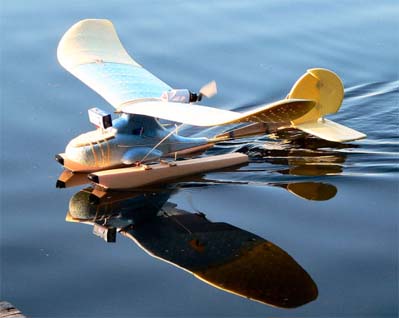
I also have a Soarstar with an Axi 2212/20 CC25 and Li-poly that carries a 2 meg Mercury camera. Since my primary interest is digital aerial photography, electrics make it a real pleasure. Taking photos over water is a real challenge ;-)
One of my friends is flying the Donald - it shows in several photos in this batch at this Web site location: http://home.primus.ca/~ironsidz/SFF
David Summers
Toronto
Return to "What's In This Issue?"
Czechmate Update
From Keith Shaw, Ann Arbor, MI
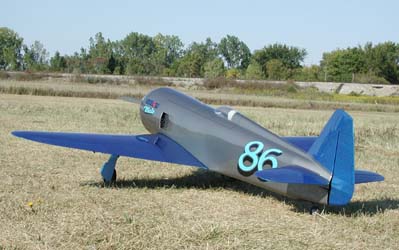
Keith's Czechmate at the Midwest RC Society Air Show
I've attached a couple of photographs that I took at the Midwest Air Show. I haven't had time to put all the detail decals on it such as the company logos, registration numbers, and pilot and owner names. They are made; I just have spent all the time getting the bugs out of the power train and radio. It probably does 100-110 mph at full power, but it is running out of prop. When I get the onboard data recorder on it I will be able to see the power loading wrt speed function. I may end up with a prop that cannot be run a full power on the ground due to too much static current, in order to carry enough pitch for high speed flight. It takes off at 1/3rd throttle so this will not be a problem.
On Sunday, at the Midwest Air Show, Chris Tucker and I put on a pylon race for the crowd, honor system to use the length of the runway as the course. He had a hand launch sport plane of about 350 sq.in. with a piped Nelson 40 in it, I used the little Folkerts. I got the jump on him early on by doing close tight turns while he flew wider ones. For TWENTY FIVE laps we were never more than 50 feet apart, sometimes he would just pull up next to me after a straightaway then I would do a quick turn and be out in front again. The race ended when he ran out of fuel!! I pulled up for a series of "victory rolls" and aerobatics while he landed and retrieved. We've come a long way...
Return to "What's In This Issue?"
Direct Connections Sea Fury
From Walt Thyng wthyng@earthlink.net
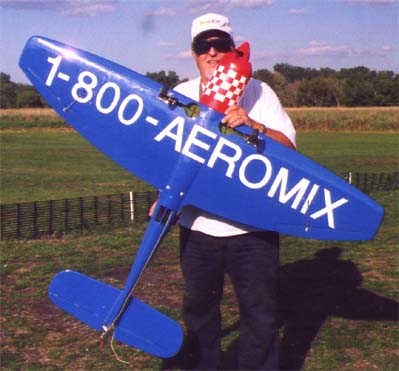
Walt & Sea Fury
Here are a couple of photos of my Direct Connections Sea Fury finished as the Reno Racer "Furias". The wingspan is 64 in. The wing area is 791 sq.in. with a weight of 8.25 lbs. Power is an Axi 4130-20 on a Thunder Power 9S2P 2100mAh Lipo back. The prop is an APC 14x12 "E". The retracts are D&B. I thought "Taz" made a good pilot for "Furias." The covering is Ultracote and the decals are ink jet water slide from Micro Mark. My 4.99 mail box -- er motor mount has worked well through 8 flights and three nose-overs. This is a great flying, very stable bird. It gets off the ground very quickly at half power.
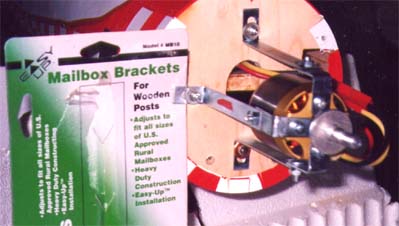
Mailbox Brackets Used to hold the AXI 4130-20
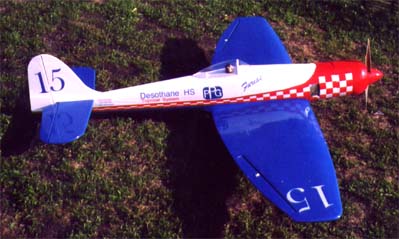
Return to "What's In This Issue?"
What In the World is Going On with AXI/Model Motors?
By Ken Myers
This is a question that I hope some Ampeer readers can clarify. The AXI line of outrunners from Model Motors in Czechoslovakia seems to have taken the electric flight world by storm. These outrunner motors seem to be everywhere and in every size.
As Ampeer readers know, my one and only experience with an AXI outrunner motor turned out to be a very poor experience. My AXI 2820/10 did not test out to be a 2820/10. The motor was labeled 2820/10, as well as the box, but testing proved that I had a much hotter wind motor.
I wrote to Model Motors directly and received a reply that I should return the motor to their US distributor, Hobby Lobby.
The reason that I wrote to Model Motors directly was that I mistakenly thought that they might be interested in what went wrong with this motor and be sure it wasn't going wrong with others.
My testing indicated that it might be an 8 wind, but no AXI 2820/8 is listed on the modelmotors.cz site as of September 28, 2005! While reading a thread on the rcgroups.com site, I did find out that such a motor exists, although not noted by Model Motors on there site. This is one site that has the 2820/8 for sale: www.strat.at/produkte/axi%20motoren.htm
The site notes an RPM/v of 1350 and the motor is to be used with 7 - 12 cells. I roughly determined that my AXI 2820/10 had an RPM/v of over 1300 as well. It is my belief that I received a mislabeled motor in the wrong box. Now I have one dead AXI, even though I did run it as if it were the 8 wind!
What furthers this belief is that my friends Bill Brown and Jim Cross had another interesting AXI experience. Bill had determined that he wanted and AXI 4120/18 for an upcoming project. He tried to purchase one at the Toledo show last April, but the only one he could get there was the AXI 4120/14, which he thought he might be able to use, if he dropped his prop size and changed the battery. When Bill and Jim finally got around to bench top test the 4120/14, Jim found that it was drawing far less amps than expected for the prop and battery combination. Actually, further testing of prop and battery combinations gave the indication that this was a 4120/18, which is what they wanted. At least they aren't disappointed, but this again showed a real problem.
Dave Stacer and Rick Sawicki, of the EFO, have been using many different AXI motors from some time now. They have run into NO problems at all, and they operate in their specifications and as advertised. Lots of folks have found this to be true.
On September 28, 2005, I visited the MM site < a href="http://www.modelmotors.cz/index.php?id=en&nc=domu">www.modelmotors.cz/index.php?id=en&nc=domu There was still no mention of an AXI 2820/8. Also there was NO mention of the following! This is from the iCare site in Canada:
www.icare-rc.com/modelmotors.htm
"The new Silver line AXI have been developed in response to the quantity of low cost clones, which look similar but do not perform as promised. Here the Silver will give the budget minded modeller the opportunity to purchase a low cost motor, with model motors manufacturing quality. The sole difference between the regular gold line and silver line is a slightly lower efficiency.
New! Silver line AXI
| Motor | Price $ US | Sale $ US |
| AXI 2208/20 | 46.00 | 42.00 |
| AXI 2208/26 | 46.00 | 42.00 |
| AXI 2208/34 | 46.00 | 42.00 |
| AXI 2212/20 | 50.00 | 46.00 |
| AXI 2212/26 | 50.00 | 46.00 |
| AXI 2212/34 | 50.00 | 46.00 |
"
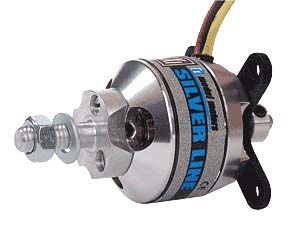
Photo from iCare site
"Another problem I had with Model Motors was that when I ordered my AXI 2820/10, there was no real prop/battery data for the AXI 2820/12. Now, on the Model Motors site, there is, but it hasn't been there very long! Given the "new" prop/battery data, I might have chosen the 2820/12, as it seems to meet the objective I have in mind.
"If there are any Ampeer readers who can shed some light on what is going on at Model Motors, it would be much appreciated! Also, if you've found an AXI motor that doesn't seem to be what it is marked or labeled, I'd like to hear about it and what made you think it was mislabeled.
Update:
Two days after I wrote the above, Model Motors updated their site! The new "Silver" line is noted, with motor data listed, but no battery/prop tests yet on those motors.
Return to "What's In This Issue?"
Cubic Wing Loading: An Explanation
By Ken Myers
In response to an email from Wade Harvey, Youngstown, Ohio
Cubic wing loading (CWL) is an indicator, just as wing loading is an indicator, for grouping airplanes by their possible flight characteristics. It has little to do with the aerodynamics needed to get the plane to fly at various sizes/scales in real, un-scaleable air. To some people, the CWL indicator seems to be more useful than the more commonly used wing loading where the ready to fly (RTF) weight is related to wing area as wing loading in oz./sq.ft. The bottom line is that the CWL indicates the relative ease of flying or skill level required to fly various aircraft and allows for groupings of these aircraft and even indicates the wind speed in mph for enjoyable flying by the everyday RC pilot.
It has been noted for many years, that with models, as well as full-size aircraft, that when two aircraft with the same wing loading are sized or scaled differently, they fly differently. On a "giant scale" model of say 1200 sq.in. a 32 oz./sq.ft. wing loading plane flies, subjectively, much differently, and seems to the pilot more easily, than a 32 oz./sq.ft. 400 sq.in. model.
The cubic wing loading (CWL) tries to indicate this by using a made up, nothing to do with real life, number. The made up number takes the two dimensional area and changes it to a "fictional" three-dimensional number. CWL does not take into consideration the actual airfoil or aerodynamics required to get the plane to fly at a given size or scale in "real" air. It simply supplies an ease of flight number for grouping and comparing aircraft by possible flight characteristics.
Cubic Wing Loading (CWL) is usually presented in units of ounces or pounds per cubic foot. Ounces work with our models, but can "look" a little strange when applied to full-size aircraft.
Here is an example:
If a model's ready to fly (RTF) weight is 60 ounces and it has 500 sq.in. of wing area, the CWL in oz./cu.ft. = 60 oz. / (500 sq.in. / 144 sq.in.)^1.5
The 500 sq.in. is divided by 144 sq.in. to give the sq.ft. because there are 144 sq.in. in a square foot.
500 sq.in. / 144 sq.in. = 3.4722222 sq.ft. By raising that answer to a factor of 1.5 you get cubic feet, in this case 3.47222^1.5 is 6.47 cubic feet. This is an entirely "fictional" number.
We create useful "fictional" numbers to help us understand many things. Electrically powered model builders and fliers are aware of and use "fictional" numbers all the time. One other "fictional" number we use a lot is the electric motor's Io when determining the amps "lost" when calculating motor power out to the shaft and prop. While based on some type of real data, it is nevertheless a "fictional" number.
When you raise a number to the 3rd power it is called cubing the number, which is the number * the number * the number.
But why raise square feet to the 1.5 if we want the number cubed? Raising a squared number by 1.5 is the same as finding the square root of the original number and then raising that number to the 3rd power. The square root of 3.4722222 cu.ft. is 1.86339 ft. when you raise 1.86339 ft. ^3 it equals 6.47 cu.ft.
I hope that clears up why raising the square of a number to the 1.5 power is cubing, or raising it to the 3rd power.
Our example aircraft then has a wing loading of 60 / (500 / 144) = 17.28 oz./sq.ft. and a cubic wing loading of 60 / (500 / 144)^1.5 = 9.27 oz./cu.ft.
How does this become useful to us?
For a smaller plane, say 250 sq.in. (250 sq.in. is not half of 500 sq.in., so don't think 1/2 the size. Actually it is about 30% smaller.) to have about the same flight characteristics, providing it was designed properly to fly at the reduced scale, it would have the same 9.27 oz./cu.ft. CWL. It would weigh (250/144)^1.5 * 9.27 oz. or 21.2 oz. and have a wing loading of 11.65 oz./sq.ft. Notice that wing loading of this 250 sq.in. model is a much lighter wing loading than the 500 sq.in. example. Yet to the pilot, with the appropriate power system and aerodynamics, the 250 sq.in. plane would, subjectively, have very much the same feel and flight characteristics as the 500 sq.in. model.
On the other hand, using a 1000 sq.in. example of the same type/task aircraft (about 30% larger) at the same cubic wing loading gives (1000 / 144) ^1.5 * 9.27 = 169.64 oz. for the RTF weight and has a wing loading of 169.64 / (1000/144) = 24.42 oz./sq.ft. Again, subjectively, to the pilot, the 1000 sq.in. model would have the same "feel" and flight characteristics as the other two sizes, given the proper power and aerodynamics.
While this doesn't always work out in practice, it does a lot of the time, enough that it is a valuable indicator, even more so than the traditional wing loading, in my opinion.
In Getting Started In Backyard Flying by Bob Aberle, Bob chose to group model types by using weight, wing area and wing loading. When looked at using CWL, some interesting things come to light.
Bob created the following groups (p.64, p.65);
Ultra Micro, Up to 2 oz., wing area 50-100 sq.in., wing loading up to 5 oz./sq.ft.
Here's another way to look at them with one specific example from each group.
Micro Lite Flyer, 1.6 oz., 68 sq.in., 3.4 oz./sq.ft, 4.93 oz./cu.ft.
DJ Aerotech Roadkill Series, 2.8 oz, 80 sq.in., 5 oz./sq.ft., 6.76 oz./cu.ft.
GWS Pico Stick, 7.7 oz., 238 sq.in., 4.7 oz./sq.ft., 3.62 oz./cu.ft.
Merlin, 17 oz, 511 sq.in., 4.9 oz./sq.ft., 2.54 oz./sq.ft
Miss-2, 29 oz., 390 sq.in., 10.8 oz./sq.ft., 6.5 oz./cu.ft.
While none of these planes would be considered "hard to fly" by an experienced R/C pilot, arranging them by wing loading and then CWL demonstrates why and how CWL can be useful.
Examples arranged by wing loading:
Micro Lite Flyer, 3.4 oz./sq.ft
GWS Pico Stick, 4.7 oz./sq.ft.
Merlin, 4.9 oz./sq.ft.
DJ Aerotech Roadkill Series, 5 oz./sq.ft.
Miss-2, 10.8 oz./sq.ft.
If you simply base the relative ease of flying on the wing loading, then the above arrangement would be from easiest to fly to hardest to fly. What is interesting is what happens to this arrangement when CWL is used.
Merlin, 2.54 oz./sq.ft
GWS Pico Stick, 3.62 oz./cu.ft.
Micro Lite Flyer, 4.93 oz./cu.ft.
Miss-2, 6.5 oz./cu.ft.
DJ Aerotech Roadkill Series, 6.76 oz./cu.ft.
If you have experienced flying some of these or similar models, you should be able to see that using CWL gives a more realistic idea about the relative ease of flight of the various models.
I have created a database of many propeller driven model aircraft including electrically powered and those powered by glow and gas engines. I have created the following categories for them. Some planes won't work in a given physical environment, where I've used a physical description, but they fly like others in the group.
An example would be the SR Batteries Eindecker E1 powered by a Zenoah G-26 gas engine. In a recent review in Model Aviation it had a given wing area of 1700 sq.in. and finished weight of 16 lb. 13.5 ounces (269.5 oz) for a wing loading of 22.83 oz./sq.ft. and CWL of 6.64 oz./cu.ft. As you will see, that fits in my group called Level 3 (typically Park Flyers), but you'd not fly it in a park! However, the ease of flight is very much like a park flyer!
My ease of flight groupings are as follows:
Level 1 (typically Indoor) ?-2.99 oz./cu.ft (3 sub-groups) [32 eplanes & 0 glow planes] {most enjoyably flown in winds up to about 3 mph}
Level 2 (typically Backyard) (3-4.99 oz./cu.ft) (6 sub-groups) [53 eplanes & 2 glow plane] {most enjoyably flown in winds up to about 5 mph}
Level 3 (typically Park Flyer) 5-6.99 oz./cu.ft. (6 sub-groups) [64 eplanes & 12 glow planes] {most enjoyably flown in winds up to about 7 mph}
Level 4 (typically Easy Sport/Trainer) 7-9.99 oz./cu.ft. (5 sub-groups) [48 eplanes & 33 glow planes] {most enjoyably flown in winds up to about 10 mph}
Level 5 (typically Sport) 10-12.99 oz./cu.ft. (6 sub-groups) [53 eplanes & 19 glow planes] {most enjoyably flown in winds up to about 13 mph}
Level 6 (typically Advanced Sport) 13-16.99 oz./cu.ft. [12 eplanes & 5 glow planes] {most enjoyably flown in winds up to about 17 mph Ð if you can say it is enjoyable to fly in winds over 15 mph}
Level 7 (typically Expert Sport) 17-20.99 oz./cu.ft. [3 eplanes & 2 glow planes] {most enjoyably flown in winds up to about 21 mph Ð if you can say it is enjoyable to fly in winds over 15 mph}
Level 8 (typically Expert) 21-??? oz./cu.ft. [2 eplanes & 1 glow plane] {most enjoyably flown in winds up to about ? mph Ð if you can say it is enjoyable to fly in winds over 15 mph}
An interesting note is that I've only collected data on two Level 2 (typically Backyard) category glow models. Of course they should not be flown in the backyard, but they do fly with the ease of typical Backyard fliers. They are Aeroworks 80-inch Profile Extra 300L with a wing area of 1600 sq.in. and weight of 161 oz., wing loading is 14.49 oz./sq.ft. and CWL is 4.35 oz./sq.ft. and the Bruce Tharpe Engineering Delta Vortex with a wing area of 1330 sq.in. and weight of 120 oz., wind loading is 12.99 oz./sq.ft and the CWL is 4.28 oz./cu.ft.
The sub-groups are based on the relationship of the prop disk area to the weight of the model in sq.in./ounce. This also relates to the possible speed of the model, since in general, larger diameter props, thus larger prop disk area props, are turned at relatively lower RPM and generally have flatter pitches. What this means is that, in general, planes that fly "on the wing" are faster than ones that fly on thrust more than the wing. Yes, they all have to have thrust to move, but it is relative!
A plane capable of 3-D maneuvers uses the prop thrust to move it about in the air rather than relying on the wing as much as a pylon racer. Yes, the pylon racer needs a lot of thrust but it is used in conjunction with the wing and aerodynamics. 3-D can be done with no wings at all, as in a 3-D capable helicopter.
Here are a couple of examples that illustrate my point. The Great Planes YAK 55 3D has a wing area of 297 sq.in. and weighs 12.3 oz. It has a wing CWL of 4.15 oz./cu.ft, making it fly like a typical Backyard flier. With a 10-inch diameter prop it has a disk area ratio of 6.39 sq.in./ounce. (10/2)^2*Pi = 78.54 sq.in. / 12.3 oz. = 6.38535 sq.in./oz. The estimated flying speed is in the neighborhood of 24 mph, at best.
The Windrider Aviation Ele-Bee (Zagi type wing) has 510 sq.in. of wing area and weighs 25.2 oz. I has a CWL of 3.78 oz./sq.ft., which is also fits into the typical Backyard flier category. Its prop diameter is 4.92-inches and has a prop disk ratio of 0.75 sq.in./oz. It could reach approximately 60 mph as reviewed.
While the Yak-55 might be able to be flown in someone's backyard, a 60 mph flying wing usually can't.
The point is, except for the orientation problem with a flying wing, they fall into the same class as far a ease of flying goes, yet to fly 3-D well, or to fly a flying wing requires more skill than a beginner has. Other planes in this group are for beginners, and once the skills are built on that type of plane, they should be able to easily transition to the YAK-55 or flying wing and feel very comfortable.
| Return to "What's In This Issue?"
The October EFO Meeting
By Ken Myers
The flying meeting was held on Saturday, October 1 at the Midwest RC Society flying field in Northville Township, MI. It was a gorgeous autumn day in Michigan. There were light winds and the temperature hovered near 70 degrees.
Pete, Caroline and Samantha Foss joined us and Pete flew his fleet of foam 3-D planes as well as his hydroplane flying boat.
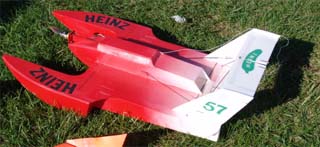
Pete's Miss Hanger One flying hydro
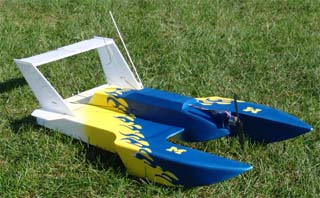
Jim's Miss Hanger One flying boat
Jim Young flew the Kantana Mini that he has written a review of for the Ezone magazine. You might want to check www.ezonemag.com to see if it has been posted yet. He also flew his beautiful flying red Comet twin. It is his own design, and is as good looking as it is flying. He also flew his hydroplane flying boat, which will also be featured in an upcoming review.
Bob Blau had several nice planes, including a Mini Funtana. I had a chance to "test" fly his GWS P-51. It hadn't been working well for him, and had previously a couple of hard meetings with the ground. He replaced the power system, and the test flight went okay. It seemed to me to be too heavy, and slightly tail-heavy, but was flyable. It was not a pleasurable experience though as it tipped stalled badly.
James Maughan had his fleet of Mountain Models planes with him, and flew and flew and flew them. He loves the quality of the Mountain Models kits and is especially fond on the flat-wing Dandy! It is a great flier.

Rick's Flite Streak & Tutor
Rick Sawicki checked out his new control line epowered Flite Streak and also flew his CL Tutor. The Flite Streak needed to have a warp removed from the wing, and now flies great. The Tutor flew all of the CL precision aerobatics very well. More on both these planes later. Rick flew some of his RC fleet and then headed north to Flint for a control line meet.
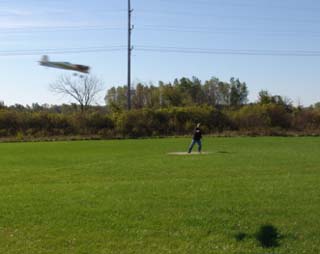
Rick flying the ePowered Tutor
Rudi Reinhard has his nice flying E3D, an Attitude electric and his glow aerobatic plane with him. Rudi spent a lot of time in the air with his electrics.
Richard Utkan had several of his planes there to fly and generally BSed along with me.
I did have my trusty SR Batteries X-250 there, but never did get around to flying it. I also shared some information on my new favorite etool, the Hyperion Emeter. There was a lot of talking a sharing going on.
It was interesting to note that during the whole time we were at the Midwest field, not a single Midwest member came out with a glow or gas powered plane on such a glorious day, if you don't count the several of us who also belong to Midwest.
The Miss Hanger One kits are available from; Hangar One Hobbies, 5350 Commerce Blvd. St. A, Rohnert Park, CA 94928 (707) 585-3170. The price I found was $60 plus shipping. Call for more info. Yes, they do take off of the grass and pavement!
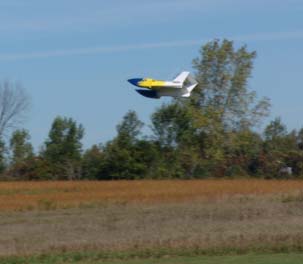
Jim's flying boat doing what flying boats do
Jim Young's review of the Miss Hanger One can be found online at the Ezone Magazine. You'll find the magazine at http://www.ezonemag.com and Jim's review article at www.rcgroups.com/links/index.php?id=4882
A little bonus:
Keith Shaw and I went flying the previous Sunday and I took a few more photos of the Czechmate to share.
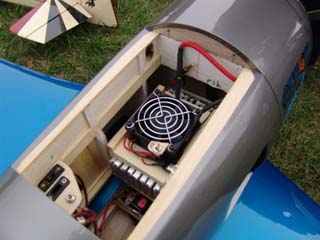
Battery cooling fan has been added over the Kokam 3200 mAh cells

Top left side view. Beautiful homemade spinner.
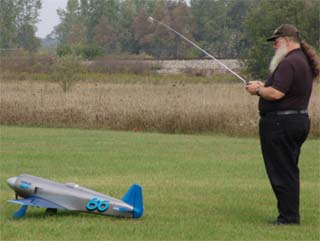
Keith Shaw getting ready for takeoff.
Return to "What's In This Issue?"
How Do I Make It Watertight?
From Rich Flinchbaugh
7 Avon Lane
South Dennis, MA 02660
email: r.flinchbaugh@att.net
Hi Ken,
Here's an important issue that I have never seen addressed - completely.
Would you and your readers comment on a practical method of keeping the new and expensive Lithium battery packs both dry and cool in a potentially wet environment. See the photo for an idea, but it's untried!
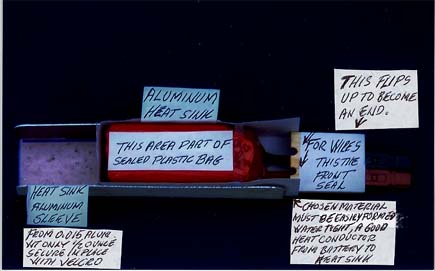
I wonder what material might work well for the battery wrap? I have been advised that splashing or submerging a pack will destroy it, as well as over-heating, due to insufficient cooling. A lot of model seaplane fliers would benefit from some help here.
I anxiously await some responses.
Sincerely,
Rich Flinchbaugh
Return to "What's In This Issue?"
Herr Pitts Conversion
From Jim Breeyear james.breeyear@uvm.edu
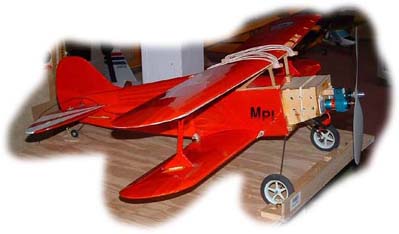
It really surprised me when it flew even better than when it was powered with the .074 Norvell.
The details are:
Motor: HiMaxx 2025/4246 brushless, beam mounted
Prop: 10-4.7 parkflyer type
Battery: 3 cell LiPoly 2 amp capacity
ESC: Castle Creations 25 controller
Radio: 4 channel minuature servos
Weight: 1lb 10 oz. all up. (26 oz.)
The conversion consisted of installing small servos; removing the MonoKote on the wings and body where possible and applying light weight covering.
The pushrods were removed and I installed small diameter lightweight rods. I used Z-bends where possible. I installed large 2 1/2" Superlite wheels.
I made sure the wheels were both free to rotate and that the airplane tracked straight on the ground with the rudder centered. I used fuel tubing to keep the wheels on the axels.
I drilled 3/8" holes in the firewall box to vent the controller and battery. I did end up mounting the controller under the firewall box and I put the battery behind the firewall and extended the battery leads out through a hole so that I could make the connections to the controller without having to take the lower wing off.
The center of gravity is 2 5/8" behind the top wing center leading edge.
Very important, don't use excessive throws on the control surfaces. It doesn't take much input to loop or roll.
Flying:
I bring up the power briskly. Take off from grass is straight and rolls forward about 15 feet into about 5 knot wind before the wheels are off. It will climb very near vertically with this power / prop setup. I wouldn't attempt to put any less power under the cowl. It may cause takeoffs to be a little squirrelly. I don't like to chase tail-draggers around the field on takeoff. The rest is pretty much as usual flying, but on landing I keep the motor on high idle until I am a few inches off the ground then I chop to low idle. It hasn't nosed over yet.
The next project for this airplane is floats, as I like to fly on the snow and water. Can't wait!
It is a pretty simple conversion. I'd like to thank Sal (Northeast Sailplane Products) for helping to pick out the power plant and prop.
The attached photo shows the plane without the cowl.
Sincerely and thanks,
Jim Breeyear
Thanks for sharing your project with us Jim! Here's a little more data I've added based on your information and info from the Herr site www.iflyherr.com. KM
Wing area: 301 sq.in.
Wing loading: 12.44 oz./sq.ft.
CWL: 8.6 oz./cu.ft. Level 4 (typically Easy Sport/Trainer)
Return to "What's In This Issue?"
News From Skymaster RC Club!
You and the members of your club are invited to spend an evening with AMA President Dave Brown at the next Skymasters meeting on Wednesday, October 26, 2005 at 7:30 PM. The meeting will be held at our regular location: Larson Middle School, 222 East Long Lake Troy, Michigan 48085 (Long Lake is 18 Mile Road - Larson is 1/4 mile east of John R.)
This will be a very informative meeting with an opportunity to speak directly to Dave about your concerns.
Please visit our website for other speaker information but here are some highlights:
November 9, 2005 Pete Bergstrom, Horizon Hobbies Director of Engine Development. Pete promises that we will see something new. Come with your tough engine questions. (NOTE DIFFERENT MEETING LOCATION-SEE WEB SITE)
January 11, 2006 Lt. Col Alexander Jefferson, Tuskegee Airman will speak of his experiences flying P-51 in WW II, Larson Middle School (Don't miss this one! He spoke at Midwest a while ago and is excellent! KM)
January 25, 2006 Andrew Jesky, ETOC Champion will speak of his experiences and trimming aircraft. Larson Middle School
February 15, 2006 SWAP SHOP, One week earlier than usual because of school closing, Larson Middle School
Visit www.skymasters.org or call: Joe Hass, President of Skymasters at 248-321-7934
Return to "What's In This Issue?"
| |
















